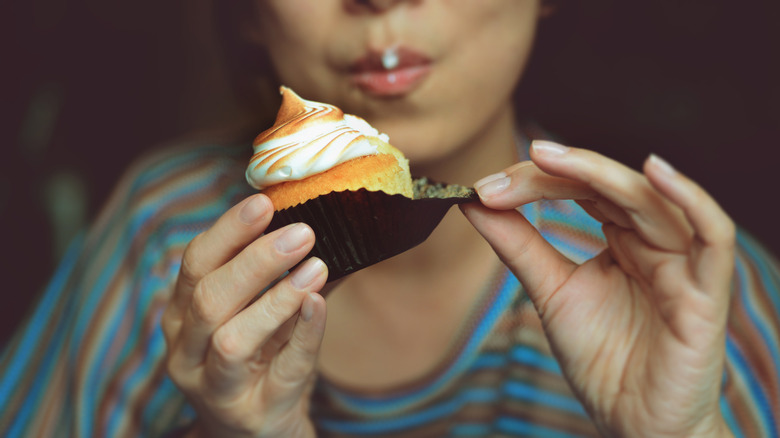TSA's Sticky Stance On Frosting Every Traveler Should Be Aware Of
Let's be honest: There are few things as infuriating and heartbreaking as hearing a TSA officer tell you something in your carry-on isn't allowed to make it past security. Whether it's the expensive bottle of perfume you bought on vacation, a brand new water bottle that you haven't even opened yet, or a pair of nail scissors you forgot to toss back into your checked luggage before zipping it up, not following the strict TSA carry-on luggage rules usually results is the same outcome: your stuff going in the trash.
However, out of all the surprising things you can't bring through TSA, there's one specific food restriction that's caused quite a stir with dessert-loving travelers — and it's all to do with frosting. The debate reached a new level of media and public attention during 2012's infamous Cupcakegate scandal, when a TSA agent in Las Vegas put down a hard "no" and confiscated a traveler's cupcake in a jar for having too much frosting (if that's even a thing).
At the end of the day, frosting falls under the TSA's definition of a liquid or gel (the same one most of us learned back in elementary school) because it takes the shape of its container. This also applies to spreadable goods like peanut butter (yes, it's a liquid), creamy dips (yes, they're considered a liquid too), and that side of guac you'd been saving to enjoy a little later (yep, TSA considers guacamole a liquid as well). This ultimately means that any separate container of frosting (the key word here is separate) that you try to bring through security will be subject to the standard 3.4-ounce limit that's enforced on all your other items.
How to ensure you get to keep your frosting (and eat it too)
That said, flying with frosting isn't always a lost cause. Although the agency does consider standalone frosting a liquid or gel, most TSA agents will happily make an exception for cake and pie (yes, even frosted ones). So, what's the difference? Well, put simply, it all boils down to presentation. Because, while your run-of-the-mill, pre-frosted goodies can usually pass through airport security without any major issues, that separate tub of buttercream must follow the same rules as your travel-sized toiletries. Otherwise, it's destined to meet a pretty untimely demise in the security line garbage can.
Once they've made it through security intact, your frosted goods can stay safe and edible with the proper planning. First, make sure they're packed neatly into a sturdy container that'll prevent them from moving around too much. Along with that, you're going to want to ensure that your treats are always standing upright on a flat surface. Otherwise, they might turn into a mushy mess once you touch down. Finally, keep in mind that while most baked goods can stay fresh for a few days at room temperature, any food that's made using dairy is typically only safe unrefrigerated for about two hours. If your journey's any longer than that, consider bringing along some fully frozen gel packs (yes, they're allowed as they're completely frozen) to keep things cool for longer.

